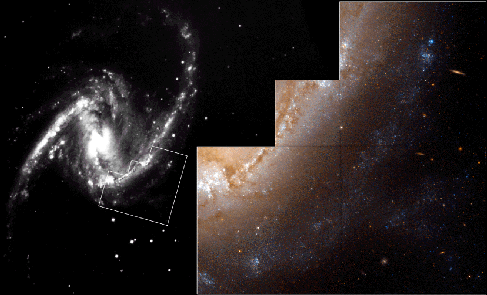Explanation: Our Universe is expanding. Distant galaxies appear to recede from us at ever-increasing speeds. What is the rate of expansion? How long has it been expanding? What will be its ultimate fate? Two groups of astronomers are searching vigorously for answers to these fundamental questions using the Hubble Space Telescope (HST). The teams have recently announced conflicting measurements of the Hubble constant, a number which represents the expansion rate of the Universe. Astronomer Wendy Freedman and her collaborators have used pulsating stars called Cepheids to measure the distance to galaxies like the Fornax cluster barred spiral galaxy NGC1365 shown above. The ground based photo (left) shows an inset locating the HST image (right) which Freedman and team have used to identify some 50 Cepheids. Their distance and velocity measurements determine Hubble's constant to be about 80 kilometers per second per megaparsec which means that galaxies one megaparsec (3 million lightyears) distant appear to recede from us at a speed of 80 kilometers per second. Conflicting results indicating a substantially slower expansion rate (smaller Hubble constant) are being reported by astronomer Allan Sandage and collaborators. The value of Hubble's constant was recently the subject of a popular public debate titled "The Scale of the Universe 1996: The Value of Hubble's Constant".
1999 2000 2001 2002 2003 2004 2005 2006 2007 2008 2009 2010 2011 2012 2013 2014 2015 2016 2017 2018 2019 2020 2021 2022 2023 2024 2025 |
Yanvar' Fevral' Mart Aprel' Mai Iyun' Iyul' Avgust Sentyabr' Oktyabr' Noyabr' Dekabr' |
NASA Web Site Statements, Warnings, and Disclaimers
NASA Official: Jay Norris. Specific rights apply.
A service of: LHEA at NASA / GSFC
& Michigan Tech. U.
|
Publikacii s klyuchevymi slovami:
universe - HST - Cefeidy - Rasshirenie Vselennoi - Postoyannaya Habbla
Publikacii so slovami: universe - HST - Cefeidy - Rasshirenie Vselennoi - Postoyannaya Habbla | |
Sm. takzhe:
Vse publikacii na tu zhe temu >> | |
Mneniya chitatelei [14]
